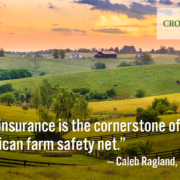Crop Insurance Helps Preserve Farming for Future Generations
Farming is a unique profession in so many ways. First, it is more like a calling — to be part of God’s gifts here, and a steward of these gifts. To follow a crop from seed to harvest, or to see an animal born and grow to maturity — that’s a lot of the reason we do what we do.
But farming is different from other professions in other ways as well, including the unique risks and unpredictabilities we face every year. Farmers, for example, are always at the mercy of the weather. A 200-bushel corn crop can quickly become a 50-bushel corn crop under the wrong conditions.
In addition, we face a volatile market and never know which way the pendulum is going to swing. Lately, it hasn’t been swinging in our direction.
Thankfully, we have tools like crop insurance that help us manage risks like these. I feel strongly that crop insurance is critical to preserving our farms for future generations. So strongly, in fact, that in addition to being a farmer, I have also served as a crop insurance agent for fellow farmers for nearly two decades.
In my role as a crop insurance agent, I work with growers to help them purchase protection they need whether they are starting a farm, or preparing for their next crop.
For beginning farmers, having this protection is especially important. Many farmers starting out rely on banks for operating loans and these banks often require crop insurance so that farmers can pay back these loans if they have a bad year.
It has been extremely rewarding for me to work with these young farmers and to play a role in helping them not only get started in business, but stay in business despite the numerous challenges farm country has experienced in recent years.
During the severe drought of 2012, for example, our area had terrible crop yields. That year was hard enough on established farmers, but for beginning farmers I know that having crop insurance played an integral role in their survival.
There are a few misconceptions out there about crop insurance, which have become especially widespread during the ongoing Farm Bill negotiations. But let’s be clear: crop insurance is not a handout.
Farmers purchase crop insurance out of their own pockets. On average, farmers spend $3.5 to $4 billion per year out for crop insurance coverage. Last year in Kentucky, farmers collectively paid $57 million for coverage. As is the case with other types of insurance, we must prove that we have met a deductible to be eligible for a payment for a portion of our loss.
Because of the unique risks involved in farming, the federal government also provides support to reduce the cost to farmers. If we didn’t have this federal support, crop insurance would simply not be affordable most of America’s farmers and ranchers.
Of note, before crop insurance was widely available and efficient like it is today, the cost of natural disasters fell directly on U.S. taxpayers by way of disaster bills. And they took forever to get to the farm.
I am fortunate to be the eighth generation of my family to farm in Larue County though I didn’t inherit family farm land. We purchased our farm more than a decade ago, basically starting from scratch. It hasn’t always been easy, but it is our way of life — our calling. Agriculture has always been the backbone of our country, and I would love for one or all three of my children to carry on this tradition.
In order for that to happen, we have to protect crop insurance.
Jeremy Hinton, farmer and crop insurance agent, Hodgenville, Kentucky

